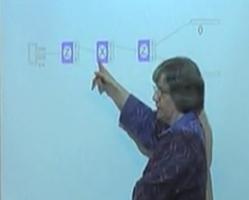How Making Measurements Affect Results in Quantum Systems (5 minutes)
- This lecture is designed to explain the classically unexpected results of the Stern-Gerlach experiment in more physically interpretable terms.
- Let's analyze the following Stern-Gerlach apparatus: a z-oriented device whose $\vert+ \rangle$ particles enter an x-oriented device whose $\vert+ \rangle_{x}$ particles enter another z-oriented device as seen below.
- Now, let the oven be a sock shooter. Then, each z-oriented device sorts the socks into long and short socks ($\vert + \rangle$ or $\vert - \rangle$ particles) while the x-oriented device sorts the socks into black and white socks ($\vert + \rangle_{x}$ or $\vert - \rangle_{x}$ particles).
- Classically: It would be expected that, after the first two devices sort out only long, black socks, the third device that sorts the socks should only have long socks ($\vert+ \rangle$ particles) come out.
- Run the experiment to show that this is not what happens quantum mechanically. It appears that the particles running through the sorters “forgot” whether they were long or short.
- Now, set the x-oriented device to recombine both the black socks and white socks ($\vert+ \rangle_{x}$ and $\vert- \rangle_{x}$ beams) back into the final z-oriented device. A device that recombines two beams in this way is called an interferometer. Run the experiment again and show the class that you will only get long socks ($\: \vert+ \rangle$ particles) out of the final z-oriented device as classically expected. The socks now remember if they were long or short after the beam is recombined.
- Perform the same experiment with the “watch” feature on. This shows that if we observe what each individual particle is sorted as at each device, then the final sorter will once again return both short socks and long socks ($\vert + \rangle$ and $\vert - \rangle$ particles).
- To mathematically interpret when one case is occuring as opposed to another, we use observables which operate on quantum states. Observing what state a particle is in changes the state and causes the sorting to occur differently.
Be sure to make the correspondence between the quantum mechanical case with particles and the sorting of socks clear throughout the exercise. Not keeping the two linked through the activity can result in more confusion than clarification.
